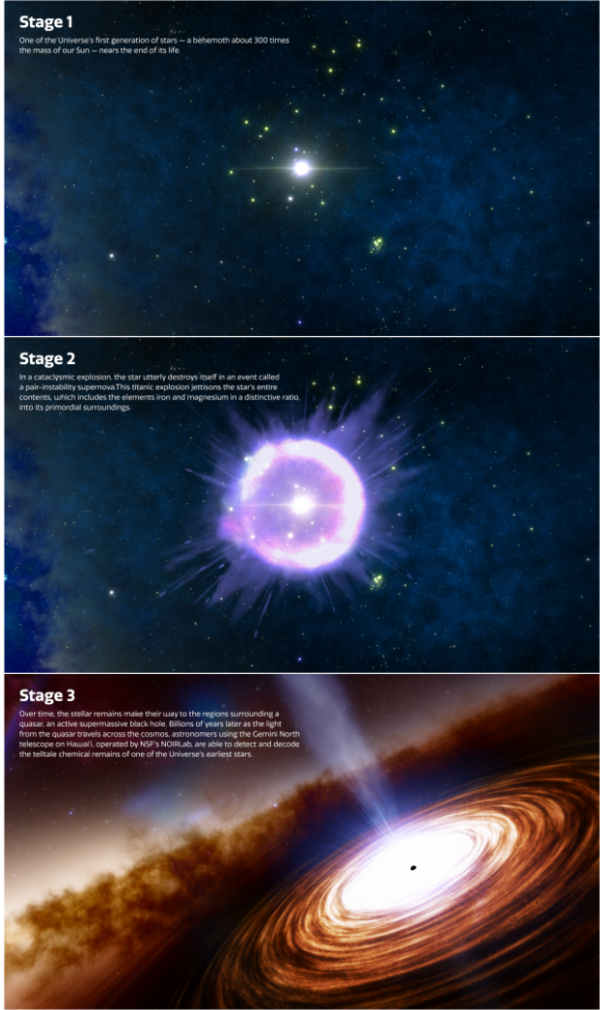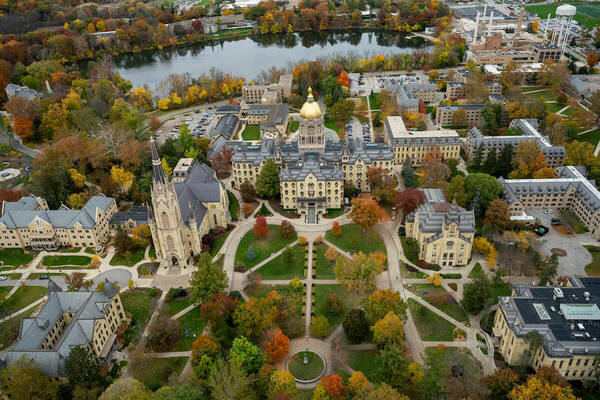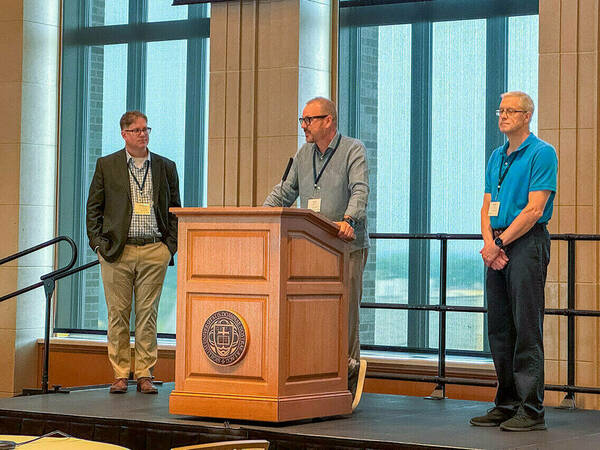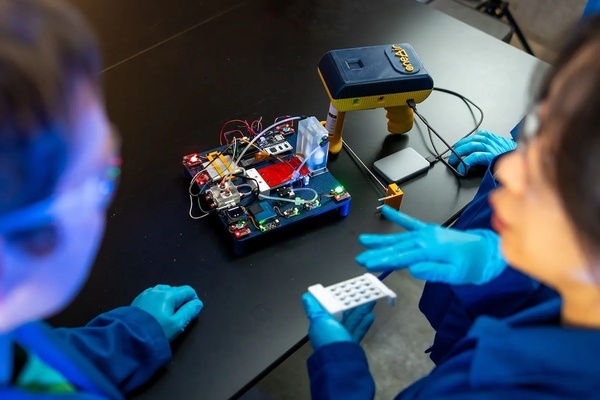Astrophysicists find evidence for the presence of the first stars
An international group of researchers, including a professor at the University of Notre Dame, has found evidence for the earliest stars in the universe, called Population III (Pop III) stars, in the spectrum of a distant quasar. The paper was published in September in The Astrophysical Journal.
Researchers in this international collaboration led by Yuzuru Yoshii, professor at the University of Tokyo and laureate professor at the University of Arizona, and Timothy Beers, the Grace-Rupley Professor of Physics at Notre Dame, discovered that a distant quasar was highly enriched with iron, leading to an extremely low magnesium to iron ratio. The most likely explanation for this ratio of magnesium to iron in the quasar is that it was produced by an exotic supernova, called a pair-instability supernova (PISN).
“Stars that undergo a PISN explosion may be among the first to have been born, and be responsible for the rapid enrichment of distant galaxies now being studied with the James Webb Space Telescope,” Beers said.
Though predicted theoretically, until now convincing evidence for Pop III stars had not been found, even though astronomers have been interested in the possible existence of these stars for decades. Researchers had sought chemical evidence for a previous generation of such stars in the halo of the Milky Way, with at least one tentative identification discovered, Beers said.
Yoshii said he has been interested in the nature of the very first stars born in the universe for his entire career. “It has been a lifelong dream of mine that we might actually study the nature of the first stars from observations, and now it appears to be coming true,” he said.
However, “the clearest signature of a PISN is probably the extremely low magnesium/iron abundance ratio found in the quasar that is the subject of this study,” Beers said.
PISN supernovae are associated with stars that are 150 to 300 times the mass of the sun. These stars live only 2 to 3 million years — compared with the sun, which is more than 4 billion years old — so direct observations of them are not expected in the Milky Way. However, astronomers are hoping to identify them from studies of their light curves. Light curves show the rise and fall of the light generated in the explosion.
“This still would prove to be a very challenging observation, requiring long-term monitoring of many objects in hopes of catching their explosions ‘in the act,’” Beers said. “Alternatively, their presence can be inferred indirectly, from studies of the chemical fingerprints they leave behind when they explode.”
Beers said he and other collaborators suspect that individual stars formed from material enriched by PISN explosions in the early Milky Way might be found in the near future, based on extensive photometric surveys with specific filters capable of measuring the magnesium/iron ratios for tens of millions of individual stars. Beers’ Galactic Archaeology group is calibrating methods to estimate the this abundance ratio of stars in photometric surveys, such as the Javalambre Photometric Local Universe Survey (J-PLUS) and Southern Photometric Local Universe Survey (S-PLUS), currently underway in both the Northern and Southern Hemispheres.
In addition to Yoshii and Beers, other researchers involved in the study include Hiroaki Sameshima and Toshikazu Shigeyama, University of Tokyo; Takuji Tsujimoto, National Astronomical Observatory of Japan; and Bruce A. Peterson, Australian National University.

To the right is a diagram showing the stages of the development of a pair-instability supernova:
- Stage 1: One of the universe's first generation of stars: A behemoth about 300 times the mass of the sun nears the end of its life.
- Stage 2: In a cataclysmic explosion, the star utterly destroys itself in a PISN, which jettisons the star's entire contents, including the elements iron and magnesium in a distinctive ratio, into its primordial surroundings.
- Stage 3: Over time, the stellar remains make their way to the regions surrounding a quasar, an active supermassive black hole. Billions of years later as the light from the quasar travels across the cosmos, astronomers using the Gemini North telescope on Hawaii, operated by the National Science Foundation's NOIRLAB, are able to detect and decode the telltale chemical remains of one of the universe's earliest stars.
Originally published by at science.nd.edu on Sept. 28.
Latest Research
- Notre Dame faculty receive prestigious early career awards from the National Science FoundationDuring the 2024-2025 academic year, four researchers in the University of Notre Dame’s Colleges of Engineering and Science received early career awards from the National Science Foundation (NSF). The Faculty Early Career Development (CAREER) Program is one of the NSF’s most prestigious awards…
- Notre Dame Center for Research Computing and College of Engineering leaders host 34th ACM International Symposium on HPDCOver the summer, the University of Notre Dame hosted the 34th ACM International Symposium on High-Performance Parallel and Distributed Computing (HPDC). HPDC brought together more than 100 attendees from around the world to the University for workshops, tutorials, paper and poster sessions, and keynote…
- Postdoc Appreciation Week: Meet three postdoctoral scholars driving research and innovation at Notre DameDuring Postdoc Appreciation Week, the Graduate School and Office of Postdoctoral Affairs celebrate our Notre Dame postdocs, their invaluable contributions, and the lasting impact they have on our drive to be a force for good in the world. To understand the full scope of the talented postdocs that Notre Dame has attracted and the research they are conducting, meet three of them.
- Notre Dame opens applications for 2026 Provost’s Postdoctoral Fellowship programThe University of Notre Dame is accepting applications for the next cohort of…
- Fighting for Better Virus DetectionAn electronic nose developed by Notre Dame researchers is helping sniff out bird flu biomarkers for faster detection and fewer sick birds. Read the story
- Notre Dame’s seventh edition of Race to Revenue culminates in Demo Day, a celebration of student and alumni entrepreneurship…












